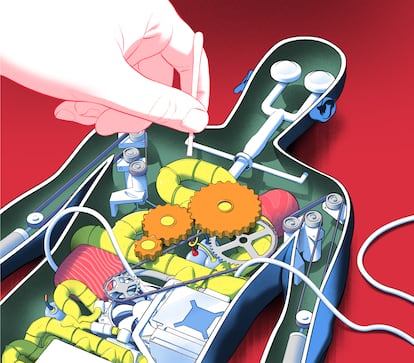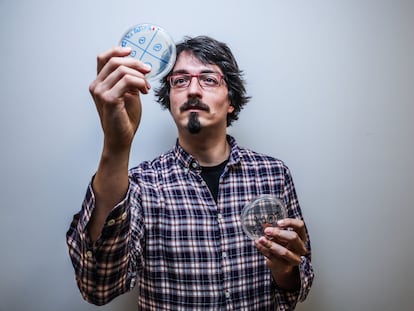If someone designed us, they sure weren’t intelligent
Despite all scientific evidence, evolution denialists maintain that it would be impossible to explain the process without a masterplan and ‘orchestra conductor.’ But in-depth biological study makes it clear that, if there was a plan to begin with, it wasn’t all that great

Biological evolution is a fact, no matter how fervent its denialists. The supporting scientific evidence is overwhelming. Evolution apologists have had to make changes to their discourse, adapting it to the extent that their arguments have become rather ridiculous. For some time, it was assumed by some that the Biblical story of creation was literal. Based on the telling of the holy book, Archbishop James Usher calculated that creation occurred on October 22 in the year 4004 BCE. This contradicts geological evidence that points to the age of Earth being around 4.5 billion years old and doesn’t explain the existence of fossils of long-gone animals estimated to be millions of years old.
No sacred text makes mention of them. Peculiar explanations have been proposed to address these issues, such as God having created the fossils to test our faith and that the dinosaurs having gone extinct because they didn’t fit into Noah’s ark — but that they did live alongside humans before the flood. Of course, human and dinosaur fossils have never been found in the same geological strata. But that hasn’t dissuaded the most evolution-recalcitrant. Pictures of primitive humans coexisting with dinosaurs are frequent in religious literature.
There is also a school of thought that skips over the most radical creationists arguments, but that maintains it is impossible to explain evolution without the existence of a previously established plan, or as they prefer to call it, intelligent design. This is an attempt to locate the idea of God within the evidence of biological evolution, trying to camouflage any religious background to lend it a patina of scientific thought. Intelligent design supporters accept that living beings evolve, but they hold that this evolution requires a director, that it cannot take place by pure chance.
One of the most beautiful parts of the Darwin-Wallace theory of evolution is that it explains biological evolution in terms of changes that take place through chance and selection, driven by the circumstances of nature. This process does not require a higher being controlling the process or a road map. The human species exists, but in other circumstances, it might not have existed. If things had been different throughout the history of our planet, its dominant species might now be fluorescent platypuses or technological ferns.
One of the arguments most often employed by intelligent design supporters is that of irreducible complexity. There are very complex biological structures, such as the human eye, which require the presence of many elements. According to the argument of Darwinian evolution denialists, these cannot have been formed by chance and the accumulation of small changes. But this is easy to refute. What happens in evolution is that some elements acquire new functions. When it comes to proteins, it is common for many to have multiple, unrelated function. Returning to our ocular example, there are animals today who still have eye structures that are more similar to those of our ancestors’ peepers.
The best argument against intelligent design is all the evidence that shows that, if a great designer does exist, they aren’t all that intelligent. In-depth biological study makes it clear that either everything happens by chance or that the person administrating all this is a dolt. Biological evolution is like trying to renovate a house that is already built. You can’t demolish it and start over, but you can knock down a partition, enlarge a doorway or add another story. The different rounds of work will eventually overlap, as in cathedrals built over the course of several centuries in which different architectural styles coexist.
There are some structures that are useful in one moment, but that must adapt to a new era and be patched up or they can become a burden, in some cases, bring about the extinction of a species. An example of such a mid-course stopgap solution would be the vas deferens that connect the testicle to the urethra, which now surrounds the urethra due to the fact that our ancestors’ testicles were higher. We could go on. Back pain, herniated discs and hemorrhoids are due to the fact that, for millions of years, we were quadrupeds and still not all that efficient when it comes to walking on two legs.
We might mention children who choke to death because their alimentary canal shares space with their respiratory tract, despite how easy it would be to separate the two, the serious infections cause by placing the main exit of solid waste from the body next to the genitals. And it’s not just in anatomy that design flaws can be seen. There are many biochemical pathways where the stopgap effect is noticeable, on which, thanks to genetic engineering, we can now improve. If we are to believe in a supreme maker, at least let them be competent.
Genetic code
The best evidence for evolution is found in our DNA. All living beings share the same genetic code, and that allows for the existence of genetic engineering. One organism’s gene can function in another and thanks to that fact, we can produce human insulin in bacteria. If a supreme being created living organisms from nothing, wouldn’t it have been more logical to give each one a different genetic code? That would have prevented interspecies gene transfer and suggest that all beings were created independently, as the Bible says.
J.M. Mulet is a professor of biotechnology.
Sign up for our weekly newsletter to get more English-language news coverage from EL PAÍS USA Edition
Tu suscripción se está usando en otro dispositivo
¿Quieres añadir otro usuario a tu suscripción?
Si continúas leyendo en este dispositivo, no se podrá leer en el otro.
FlechaTu suscripción se está usando en otro dispositivo y solo puedes acceder a EL PAÍS desde un dispositivo a la vez.
Si quieres compartir tu cuenta, cambia tu suscripción a la modalidad Premium, así podrás añadir otro usuario. Cada uno accederá con su propia cuenta de email, lo que os permitirá personalizar vuestra experiencia en EL PAÍS.
¿Tienes una suscripción de empresa? Accede aquí para contratar más cuentas.
En el caso de no saber quién está usando tu cuenta, te recomendamos cambiar tu contraseña aquí.
Si decides continuar compartiendo tu cuenta, este mensaje se mostrará en tu dispositivo y en el de la otra persona que está usando tu cuenta de forma indefinida, afectando a tu experiencia de lectura. Puedes consultar aquí los términos y condiciones de la suscripción digital.










































